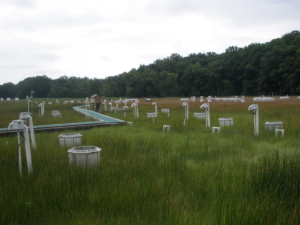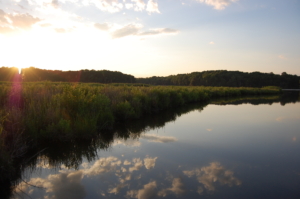Shorter marsh grasses and adapting to sea level rise

One of the experimental changes on the marsh. Credit: Tom Mozdzer.
As carbon dioxide increases, most plants respond by getting bigger. CO2 acts like fuel for most plants, allowing them to grow higher and thicker, increasing their biomass. But what happens when you look at individual plants, particularly in marsh grasses, instead of overall biomass?
Scientists had long saw that increasing CO2 led to higher biomass of marsh grasses and assumed that meant individual plants were growing larger too. But a team of scientists from the Smithsonian Environmental Research Center (SERC) and Virginia Institute of Marine Science (VIMS) found that despite an overall 20 percent increase in total biomass in the experimental chamber, individual marsh grass stems had actually shrunk in size.
Studying future marshes
The team evaluated marsh response to carbon dioxide by studying plants at the Global Change Research Wetland at SERC, a 23-hectare brackish marsh that houses 4 long-term experiments. Scientists have been working on understanding how marsh plants respond to elevated CO2 for 30 years, and SERC scientist Patrick Megonigal has spent the last 20 years there working on questions around marsh adaptation.

The study chambers on the experimental marsh. Credit: SERC staff.
In the experimental marsh, scientists are interested in understanding how plants and their microbes will respond to climate change by manipulating one factor at a time. “The goal is to understand all the mechanisms,” explained Megonigal. “Then we can understand how the marsh will change in the future.”
Former SERC postdoc Meng Lu looked at 30 years of biomass data to understand how biomass was changing and found a 20% increase in marsh grass biomass in high-CO2 chambers. However, he also found that individual stems had shrunk 16%.
The team found that the limiting factor was nitrogen.
Understanding the role of nitrogen in marsh grass growth

Drone shot of the marsh used in the study. Credit: David Klinges.
In order to continue to grow, all plants need nitrogen, and marsh grasses can maximize their nitrogen uptake by spreading their roots farther. Many marsh grasses are clonal, which means they can grow multiple stems from one plant. As their root system expands, the plant sends more stems above ground, creating plants that are shorter, but have more clones.
In order to confirm this finding, the scientists increased nitrogen in some chambers along with the CO2, and saw that plants grew more, longer stems, proving that nitrogen limitations were causing the shrinking stems in the other chambers. “Everyone always focused on the fact that there was more plant matter overall, missing the fact that individual plants were shrinking ” explained Megonigal.
Looking to the future
With this data, the team worked with Matthew Kirwan to understand marshes of the future. “The goal of the modeling was to take past data on the size of individual plants in response to elevated CO2 and extrapolate how that would impact marsh resiliency to sea level rise,” he explained.
The model included frequency of marsh flooding, sediment inputs during flood events, and size and productivity of the plants. They found that with denser stems and larger root systems, more sediments were trapped on the surface of the marsh.

Another view of the marsh used in the study. Credit: Adam Langley.
“In general, every marsh is going to have a different resistance to sea level rise,” added Kirwan. “In the Chesapeake Bay, the marshes are particularly vulnerable because there aren’t a lot of sediments in waters that flood the marshes, leaving Bay marshes vulnerable. But this study was interesting because it demonstrated a new mechanism by which marshes can respond to sea level rise.”
Kirwan is cautiously optimistic for future marshes. He found that changes in marsh plant distribution led to an extra millimeter per year of sediment accretion. That might seem small, but when sea levels are rising 4 millimeters every year, every little bit helps. Nevertheless, he cautions that it won’t help much if sea level rise rates increase in the future to rates beyond 10 mm per year, as is currently forecasted.
Next, the team hopes to look at the accumulation of underground organic matter by the larger root systems.
Kirwan concluded, “Numerical models almost always focus on the amount of biomass, not the structure of the plant communities themselves. In this case, the change in structure led to real differences in marsh response to sea level rise.”
Want more? Check out this story featured on NPR with an interview with Megonigal, and this article from the SERC blog.
